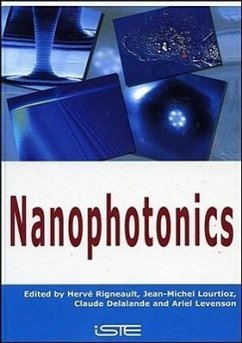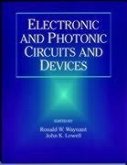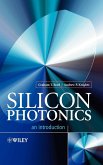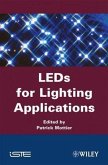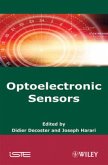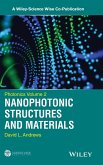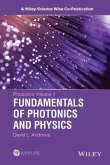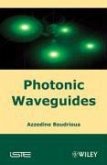Nanophotonics
Herausgeber: Rigneault, Hervé; Levenson, Ariel; Delalande, Claude; Lourtioz, Jean-Michel
Schade – dieser Artikel ist leider ausverkauft. Sobald wir wissen, ob und wann der Artikel wieder verfügbar ist, informieren wir Sie an dieser Stelle.
Nanophotonics
Herausgeber: Rigneault, Hervé; Levenson, Ariel; Delalande, Claude; Lourtioz, Jean-Michel
- Gebundenes Buch
- Merkliste
- Auf die Merkliste
- Bewerten Bewerten
- Teilen
- Produkt teilen
- Produkterinnerung
- Produkterinnerung
Nanophotonicsis a comprehensive introduction to the emerging area concerned with controlling and shaping optical fields at a subwavelength scale. Photonic crystals and microcavities are extensively described, including non-linear optical effects. Local-probe techniques are presented and are used to characterize plasmonic devices. The emerging fields of semiconductor nanocrystals and nanobiophotonics are also presented.
Andere Kunden interessierten sich auch für
![Electronic and Photonic Circuits and Devices Electronic and Photonic Circuits and Devices]() Electronic and Photonic Circuits and Devices172,99 €
Electronic and Photonic Circuits and Devices172,99 €![Silicon Photonics Silicon Photonics]() Graham T. ReedSilicon Photonics167,99 €
Graham T. ReedSilicon Photonics167,99 €![Led for Lighting Applications Led for Lighting Applications]() Patrick MottierLed for Lighting Applications170,99 €
Patrick MottierLed for Lighting Applications170,99 €![Optoelectronic Sensors Optoelectronic Sensors]() Optoelectronic Sensors170,99 €
Optoelectronic Sensors170,99 €![Photonics, Volume 2 Photonics, Volume 2]() David L AndrewsPhotonics, Volume 2157,99 €
David L AndrewsPhotonics, Volume 2157,99 €![Photonics Photonics]() David L AndrewsPhotonics537,99 €
David L AndrewsPhotonics537,99 €![Photonic Waveguides Photonic Waveguides]() Azzedine BoudriouaPhotonic Waveguides195,99 €
Azzedine BoudriouaPhotonic Waveguides195,99 €-
-
Nanophotonicsis a comprehensive introduction to the emerging area concerned with controlling and shaping optical fields at a subwavelength scale. Photonic crystals and microcavities are extensively described, including non-linear optical effects. Local-probe techniques are presented and are used to characterize plasmonic devices. The emerging fields of semiconductor nanocrystals and nanobiophotonics are also presented.
Produktdetails
- Produktdetails
- Verlag: Wiley
- Seitenzahl: 324
- Erscheinungstermin: 1. April 2006
- Englisch
- Abmessung: 243mm x 155mm x 22mm
- Gewicht: 612g
- ISBN-13: 9781905209286
- ISBN-10: 1905209282
- Artikelnr.: 21107244
- Herstellerkennzeichnung
- Libri GmbH
- Europaallee 1
- 36244 Bad Hersfeld
- gpsr@libri.de
- Verlag: Wiley
- Seitenzahl: 324
- Erscheinungstermin: 1. April 2006
- Englisch
- Abmessung: 243mm x 155mm x 22mm
- Gewicht: 612g
- ISBN-13: 9781905209286
- ISBN-10: 1905209282
- Artikelnr.: 21107244
- Herstellerkennzeichnung
- Libri GmbH
- Europaallee 1
- 36244 Bad Hersfeld
- gpsr@libri.de
Hervé Rigneault leads a group of researchers at the Fresnel Institute in France in the field of nanobiophotonics. Jean-Michel Lourtioz coordinates the French network on nanophotonics. Claude Delalande is currently working on the optical properties of semiconductor nanostructures and has been Director of the Laboratoire Pierre Aigrain since 1999. Juan Ariel Levenson is the leader of the Centre of Nanosciences of the Paris-Region, France.
Preface 13
Chapter 1. Photonic Crystals: From Microphotonics to Nanophotonics 17
Pierre VIKTOROVITCH
1.1. Introduction 17
1.2. Reminders and prerequisites 19
1.2.1. Maxwell equations 19
1.2.1.1. Optical modes 20
1.2.1.2. Dispersion characteristics 20
1.2.2. A simple case: three-dimensional and homogeneous free space 20
1.2.3. Structuration of free space and optical mode engineering 21
1.2.4. Examples of space structuration: objects with reduced dimensionality
22
1.2.4.1. Two 3D sub-spaces 22
1.2.4.2. Two-dimensional isotropic propagation: planar cavity 24
1.2.4.3. One-dimensional propagation: photonic wire 25
1.2.4.4. Case of index guiding (two- or one-dimensionality) 26
1.2.4.5. Zero-dimensionality: optical (micro)-cavity 26
1.2.5. Epilogue 27
1.3. 1D photonic crystals 28
1.3.1. Bloch modes 29
1.3.2. Dispersion characteristics of a 1D periodic medium 30
1.3.2.1. Genesis and description of dispersion characteristics 30
1.3.2.2. Density of modes along the dispersion characteristics 32
1.3.3. Dynamics of Bloch modes 33
1.3.3.1. Coupled mode theory 33
1.3.3.2. Lifetime of a Bloch mode 34
1.3.3.3. Merit factor of a Bloch mode 35
1.3.4. The distinctive features of photonic crystals 35
1.3.5. Localized defect in a photonic band gap or optical microcavity 36
1.3.5.1. Donor and acceptor levels 37
1.3.5.2. Properties of cavity modes in a 1DPC 38
1.3.5.3. Fabry-Perot type optical filter 39
1.3.6. 1D photonic crystal in a dielectric waveguide and waveguided Bloch
modes 40
1.3.6.1. Various diffractive coupling processes between optical modes 40
1.3.6.2. Determination of the dispersion characteristics of waveguided
Bloch modes 42
1.3.6.3. Lifetime and merit factor of waveguided Bloch modes: radiation
optical losses 43
1.3.6.4. Localized defect or optical microcavity 44
1.3.7. Epilogue 46
1.4. 3D photonic crystals 46
1.4.1. From dream 46
1.4.2. ... to reality 47
1.5. 2D photonic crystals: the basics 49
1.5.1. Conceptual tools: Bloch modes, direct and reciprocal lattices,
dispersion curves and surfaces 50
1.5.1.1. Bloch modes 50
1.5.1.2. Direct and reciprocal lattices 51
1.5.1.3. Dispersion curves and surfaces 52
1.5.2. 2D photonic crystal in a planar dielectric waveguide 54
1.5.2.1. An example of the potential of 2DPC in terms of angular
resolution: the super-prism effect 56
1.5.2.2. Strategies for vertical confinement in 2DPC waveguided
configurations 57
1.6. 2D photonic crystals: basic building blocks for planar integrated
photonics 59
1.6.1. Fabrication: a planar technological approach 59
1.6.1.1. 2DPC formed in an InP membrane suspended in air 59
1.6.1.2. 2DPC formed in an InP membrane bonded onto silica on silicon by
molecular bonding 60
1.6.2. Localized defect in the PBG or microcavity 62
1.6.3. Waveguiding structures 64
1.6.3.1. Propagation losses in a straight waveguide 66
1.6.3.2. Bends 67
1.6.3.3. The future of PC-based waveguides lies principally in the guiding
of light 69
1.6.4. Wavelength selective transfer between two waveguides 70
1.6.5. Micro-lazers 73
1.6.5.1. Threshold power 74
1.6.5.2. Example: the case of the surface emitting Bloch mode lazer 75
1.6.6. Epilogue 77
1.7. Towards 2.5-dimensional Microphotonics 77
1.7.1. Basic concepts 77
1.7.2. Applications 80
1.8. General conclusion 81
1.9. References 82
Chapter 2. Bidimensional Photonic Crystals for Photonic Integrated Circuits
85
Anne TALNEAU
2.1. Introduction 85
2.2. The three dimensions in space: planar waveguide perforated by a
photonic crystal on InP substrate 86
2.2.1. Vertical confinement: a planar waveguide on substrate 86
2.2.2. In-plane confinement: intentional defects within the gap 87
2.2.2.1. Localized defects 88
2.2.2.2. Linear defects 88
2.2.3. Losses 89
2.3. Technology for drilling holes on InP-based materials 90
2.3.1. Mask generation 90
2.3.2. Dry-etching of InP-based semiconductor materials 91
2.4. Modal behavior and performance of structures 92
2.4.1. Passive structures 92
2.4.1.1. Straight guides, taper 93
2.4.1.2. Bend, combiner 96
2.4.1.3. Filters 100
2.4.2. Active structures: lazers 102
2.5. Conclusion 104
2.6. References 105
Chapter 3. Photonic Crystal Fibers 109
Dominique PAGNOUX
3.1. Introduction 109
3.2. Two guiding principles in microstructured fibers 112
3.3. Manufacture of microstructured fibers 116
3.4. Modeling TIR-MOFs 117
3.4.1. The "effective-V model" 117
3.4.2. Modal methods for calculating the fields 118
3.5. Main properties and applications of TIR-MOFs 120
3.5.1. Single mode propagation 120
3.5.2. Propagation loss 120
3.5.3. Chromatic dispersion 121
3.5.4. Birefringence 123
3.5.5. Non-conventional effective areas 124
3.6. Photonic bandgap fibers 125
3.6.1. Propagation in photonic bandgap fibers 125
3.6.2. Some applications of photonic crystal fibers 127
3.7. Conclusion 128
3.8. References 129
Chapter 4. Quantum Dots in Optical Microcavities 135
Jean-Michel GERARD
4.1. Introduction 135
4.2. Building blocks for solid-state CQED 137
4.2.1. Self-assembled QDs as "artificial atoms" 137
4.2.2. Solid-state optical microcavities 139
4.3. QDs in microcavities: some basic CQED experiments 142
4.3.1. Strong coupling regime 142
4.3.2. Weak coupling regime: enhancement/inhibition of the SE rate and
"nearly" single mode SE 145
4.3.3. Applications of CQED effects to single photon sources and nanolazers
150
4.4. References 154
Chapter 5. Nonlinear Optics in Nano- and Microstructures 159
Yannick DUMEIGE and Fabrice RAINERI
5.1. Introduction 159
5.2. Introduction to nonlinear optics 160
5.2.1. Maxwell equations and nonlinear optics 160
5.2.2. Second order nonlinear processes 164
5.2.2.1. Three wave mixing 165
5.2.2.2. Second harmonic generation 166
5.2.2.3. Parametric amplification 169
5.2.2.4. How can phase matching be achieved? 170
5.2.2.5. Applications of second order nonlinearity 173
5.2.3. Third order processes 173
5.2.3.1. Four wave mixing 173
5.2.3.2. Optical Kerr effect 175
5.2.3.3. Nonlinear spectroscopy: Raman, Brillouin and Rayleigh scatterings
177
5.3. Nonlinear optics of nano- or microstructured media 177
5.3.1. Second order nonlinear optics in III-V semiconductors 178
5.3.1.1. Quasi-phase matching in III-V semiconductors 178
5.3.1.2. Quasi-phase matching in microcavity 179
5.3.1.3. Bidimensional quasi-phase matching 180
5.3.1.4. Form birefringence 180
5.3.1.5. Phase matching in one-dimensional photonic crystals 181
5.3.1.6. Phase matching in two-dimensional photonic crystal waveguide 183
5.3.2. Third order nonlinear effects 184
5.3.2.1. Continuum generation in microstructured optical fibers 184
5.3.2.2. Optical reconfiguration of two-dimensional photonic crystal slabs
184
5.3.2.3. Spatial solitons in microcavities 186
5.4. Conclusion 187
5.5. References 187
Chapter 6. Third Order Optical Nonlinearities in Photonic Crystals 191
Robert FREY, Philippe DELAYE and Gerald ROOSEN
6.1. Introduction 191
6.2. Third order nonlinear optic reminder 192
6.2.1. Third order optical nonlinearities 192
6.2.2. Some third order nonlinear optical processes 194
6.2.3. Influence of the local field 196
6.3. Local field in photonic crystals 198
6.4. Nonlinearities in photonic crystals 203
6.5. Conclusion 204
6.6. References 204
Chapter 7. Controling the Optical Near Field: Implications for
Nanotechnology 207
Frederique DE FORNEL
7.1. Introduction 207
7.2. How is the near field defined? 208
7.2.1. Dipolar emission 208
7.2.2. Diffraction by a sub-wavelength aperture 212
7.2.3. Total internal reflection 213
7.3. Optical near field microscopies 217
7.3.1. Introduction 217
7.3.2. Fundamental principles 217
7.3.3. Realization of near field probes 219
7.3.4. Imaging methods in near field optical microscopes 220
7.3.5. Feedback 222
7.3.6. What is actually measured in near field? 223
7.3.7. PSTM configuration 223
7.3.8. Apertureless microscope 225
7.3.9. Effect of coherence on the structure of near field images 226
7.4. Characterization of integrated-optical components 227
7.4.1. Characterization of guided modes 227
7.4.2. Photonic crystal waveguides 229
7.4.3. Excitation of cavity modes 230
7.4.4. Localized generation of surface plasmons 232
7.5. Conclusion 235
7.6. References 236
Chapter 8. Sub-Wavelength Optics: Towards Plasmonics 239
Alain DEREUX
8.1. Technological context 239
8.2. Detecting optical fields at the sub-wavelength scale 240
8.2.1. Principle of sub-wavelength measurement 240
8.2.2. Scattering theory of electromagnetic waves 242
8.2.3. Electromagnetic LDOS 244
8.2.4. PSTM detection of the electric or magnetic components of optical
waves 246
8.2.5. SNOM detection of the electromagnetic LDOS 247
8.3. Localized plasmons 249
8.3.1. Squeezing of the near-field by localized plasmons coupling 250
8.3.2. Controling the coupling of localized plasmons 251
8.4. Sub- optical devices 254
8.4.1. Coupling in 254
8.4.2. Sub- waveguides 254
8.4.3. Towards plasmonics: plasmons on metal stripes 255
8.4.4. Prototypes of submicron optical devices 256
8.5. References 263
Chapter 9. The Confined Universe of Electrons in Semiconductor Nanocrystals
265
Maria CHAMARRO
9.1. Introduction 265
9.2. Electronic structure 266
9.2.1. "Naif" model 266
9.2.1.1. Absorption and luminescence spectra 269
9.2.2. Fine electronic structure 271
9.2.2.1. Size-selective excitation 271
9.2.2.2. "Dark" electron-hole pair 274
9.3. Micro-luminescence 276
9.4. Auger effect 279
9.5. Applications in nanophotonics 281
9.5.1. Semiconductor nanocrystals: single photon sources 281
9.5.2. Semiconductor nanocrystals: new fluorescent labels for biology 283
9.5.3. Semiconductor nanocrystals: a new active material for tunable lazers
285
9.6. Conclusions 286
9.7. References 287
Chapter 10. Nano-Biophotonics 293
Herve RIGNEAULT and Pierre-Francois LENNE
10.1. Introduction 293
10.2. The cell: scale and constituents 295
10.3. Origin and optical contrast mechanisms 296
10.3.1. Classical contrast mechanisms: bright field, dark field, phase
contrast and interferometric contrast 297
10.3.2. The fluorescence contrast mechanism 298
10.3.2.1. The lifetime contrast 300
10.3.2.2. Resolving power in fluorescence microscopy 301
10.3.3. Non-linear microscopy 303
10.3.3.1. Second harmonic generation (SHG) 304
10.3.3.2. Coherent anti-Stokes Raman scattering (CARS) 305
10.4. Reduction of the observation volume 307
10.4.1. Far field methods 308
10.4.1.1. 4Pi microscopy 308
10.4.1.2. Microscopy on a mirror 309
10.4.1.3. Stimulated emission depletion: STED 309
10.4.2. Near field methods 311
10.4.2.1. NSOM 312
10.4.2.2. TIRF 312
10.4.2.3. Nanoholes 313
10.5. Conclusion 314
10.6. References 314
List of Authors 319
Index 323
Chapter 1. Photonic Crystals: From Microphotonics to Nanophotonics 17
Pierre VIKTOROVITCH
1.1. Introduction 17
1.2. Reminders and prerequisites 19
1.2.1. Maxwell equations 19
1.2.1.1. Optical modes 20
1.2.1.2. Dispersion characteristics 20
1.2.2. A simple case: three-dimensional and homogeneous free space 20
1.2.3. Structuration of free space and optical mode engineering 21
1.2.4. Examples of space structuration: objects with reduced dimensionality
22
1.2.4.1. Two 3D sub-spaces 22
1.2.4.2. Two-dimensional isotropic propagation: planar cavity 24
1.2.4.3. One-dimensional propagation: photonic wire 25
1.2.4.4. Case of index guiding (two- or one-dimensionality) 26
1.2.4.5. Zero-dimensionality: optical (micro)-cavity 26
1.2.5. Epilogue 27
1.3. 1D photonic crystals 28
1.3.1. Bloch modes 29
1.3.2. Dispersion characteristics of a 1D periodic medium 30
1.3.2.1. Genesis and description of dispersion characteristics 30
1.3.2.2. Density of modes along the dispersion characteristics 32
1.3.3. Dynamics of Bloch modes 33
1.3.3.1. Coupled mode theory 33
1.3.3.2. Lifetime of a Bloch mode 34
1.3.3.3. Merit factor of a Bloch mode 35
1.3.4. The distinctive features of photonic crystals 35
1.3.5. Localized defect in a photonic band gap or optical microcavity 36
1.3.5.1. Donor and acceptor levels 37
1.3.5.2. Properties of cavity modes in a 1DPC 38
1.3.5.3. Fabry-Perot type optical filter 39
1.3.6. 1D photonic crystal in a dielectric waveguide and waveguided Bloch
modes 40
1.3.6.1. Various diffractive coupling processes between optical modes 40
1.3.6.2. Determination of the dispersion characteristics of waveguided
Bloch modes 42
1.3.6.3. Lifetime and merit factor of waveguided Bloch modes: radiation
optical losses 43
1.3.6.4. Localized defect or optical microcavity 44
1.3.7. Epilogue 46
1.4. 3D photonic crystals 46
1.4.1. From dream 46
1.4.2. ... to reality 47
1.5. 2D photonic crystals: the basics 49
1.5.1. Conceptual tools: Bloch modes, direct and reciprocal lattices,
dispersion curves and surfaces 50
1.5.1.1. Bloch modes 50
1.5.1.2. Direct and reciprocal lattices 51
1.5.1.3. Dispersion curves and surfaces 52
1.5.2. 2D photonic crystal in a planar dielectric waveguide 54
1.5.2.1. An example of the potential of 2DPC in terms of angular
resolution: the super-prism effect 56
1.5.2.2. Strategies for vertical confinement in 2DPC waveguided
configurations 57
1.6. 2D photonic crystals: basic building blocks for planar integrated
photonics 59
1.6.1. Fabrication: a planar technological approach 59
1.6.1.1. 2DPC formed in an InP membrane suspended in air 59
1.6.1.2. 2DPC formed in an InP membrane bonded onto silica on silicon by
molecular bonding 60
1.6.2. Localized defect in the PBG or microcavity 62
1.6.3. Waveguiding structures 64
1.6.3.1. Propagation losses in a straight waveguide 66
1.6.3.2. Bends 67
1.6.3.3. The future of PC-based waveguides lies principally in the guiding
of light 69
1.6.4. Wavelength selective transfer between two waveguides 70
1.6.5. Micro-lazers 73
1.6.5.1. Threshold power 74
1.6.5.2. Example: the case of the surface emitting Bloch mode lazer 75
1.6.6. Epilogue 77
1.7. Towards 2.5-dimensional Microphotonics 77
1.7.1. Basic concepts 77
1.7.2. Applications 80
1.8. General conclusion 81
1.9. References 82
Chapter 2. Bidimensional Photonic Crystals for Photonic Integrated Circuits
85
Anne TALNEAU
2.1. Introduction 85
2.2. The three dimensions in space: planar waveguide perforated by a
photonic crystal on InP substrate 86
2.2.1. Vertical confinement: a planar waveguide on substrate 86
2.2.2. In-plane confinement: intentional defects within the gap 87
2.2.2.1. Localized defects 88
2.2.2.2. Linear defects 88
2.2.3. Losses 89
2.3. Technology for drilling holes on InP-based materials 90
2.3.1. Mask generation 90
2.3.2. Dry-etching of InP-based semiconductor materials 91
2.4. Modal behavior and performance of structures 92
2.4.1. Passive structures 92
2.4.1.1. Straight guides, taper 93
2.4.1.2. Bend, combiner 96
2.4.1.3. Filters 100
2.4.2. Active structures: lazers 102
2.5. Conclusion 104
2.6. References 105
Chapter 3. Photonic Crystal Fibers 109
Dominique PAGNOUX
3.1. Introduction 109
3.2. Two guiding principles in microstructured fibers 112
3.3. Manufacture of microstructured fibers 116
3.4. Modeling TIR-MOFs 117
3.4.1. The "effective-V model" 117
3.4.2. Modal methods for calculating the fields 118
3.5. Main properties and applications of TIR-MOFs 120
3.5.1. Single mode propagation 120
3.5.2. Propagation loss 120
3.5.3. Chromatic dispersion 121
3.5.4. Birefringence 123
3.5.5. Non-conventional effective areas 124
3.6. Photonic bandgap fibers 125
3.6.1. Propagation in photonic bandgap fibers 125
3.6.2. Some applications of photonic crystal fibers 127
3.7. Conclusion 128
3.8. References 129
Chapter 4. Quantum Dots in Optical Microcavities 135
Jean-Michel GERARD
4.1. Introduction 135
4.2. Building blocks for solid-state CQED 137
4.2.1. Self-assembled QDs as "artificial atoms" 137
4.2.2. Solid-state optical microcavities 139
4.3. QDs in microcavities: some basic CQED experiments 142
4.3.1. Strong coupling regime 142
4.3.2. Weak coupling regime: enhancement/inhibition of the SE rate and
"nearly" single mode SE 145
4.3.3. Applications of CQED effects to single photon sources and nanolazers
150
4.4. References 154
Chapter 5. Nonlinear Optics in Nano- and Microstructures 159
Yannick DUMEIGE and Fabrice RAINERI
5.1. Introduction 159
5.2. Introduction to nonlinear optics 160
5.2.1. Maxwell equations and nonlinear optics 160
5.2.2. Second order nonlinear processes 164
5.2.2.1. Three wave mixing 165
5.2.2.2. Second harmonic generation 166
5.2.2.3. Parametric amplification 169
5.2.2.4. How can phase matching be achieved? 170
5.2.2.5. Applications of second order nonlinearity 173
5.2.3. Third order processes 173
5.2.3.1. Four wave mixing 173
5.2.3.2. Optical Kerr effect 175
5.2.3.3. Nonlinear spectroscopy: Raman, Brillouin and Rayleigh scatterings
177
5.3. Nonlinear optics of nano- or microstructured media 177
5.3.1. Second order nonlinear optics in III-V semiconductors 178
5.3.1.1. Quasi-phase matching in III-V semiconductors 178
5.3.1.2. Quasi-phase matching in microcavity 179
5.3.1.3. Bidimensional quasi-phase matching 180
5.3.1.4. Form birefringence 180
5.3.1.5. Phase matching in one-dimensional photonic crystals 181
5.3.1.6. Phase matching in two-dimensional photonic crystal waveguide 183
5.3.2. Third order nonlinear effects 184
5.3.2.1. Continuum generation in microstructured optical fibers 184
5.3.2.2. Optical reconfiguration of two-dimensional photonic crystal slabs
184
5.3.2.3. Spatial solitons in microcavities 186
5.4. Conclusion 187
5.5. References 187
Chapter 6. Third Order Optical Nonlinearities in Photonic Crystals 191
Robert FREY, Philippe DELAYE and Gerald ROOSEN
6.1. Introduction 191
6.2. Third order nonlinear optic reminder 192
6.2.1. Third order optical nonlinearities 192
6.2.2. Some third order nonlinear optical processes 194
6.2.3. Influence of the local field 196
6.3. Local field in photonic crystals 198
6.4. Nonlinearities in photonic crystals 203
6.5. Conclusion 204
6.6. References 204
Chapter 7. Controling the Optical Near Field: Implications for
Nanotechnology 207
Frederique DE FORNEL
7.1. Introduction 207
7.2. How is the near field defined? 208
7.2.1. Dipolar emission 208
7.2.2. Diffraction by a sub-wavelength aperture 212
7.2.3. Total internal reflection 213
7.3. Optical near field microscopies 217
7.3.1. Introduction 217
7.3.2. Fundamental principles 217
7.3.3. Realization of near field probes 219
7.3.4. Imaging methods in near field optical microscopes 220
7.3.5. Feedback 222
7.3.6. What is actually measured in near field? 223
7.3.7. PSTM configuration 223
7.3.8. Apertureless microscope 225
7.3.9. Effect of coherence on the structure of near field images 226
7.4. Characterization of integrated-optical components 227
7.4.1. Characterization of guided modes 227
7.4.2. Photonic crystal waveguides 229
7.4.3. Excitation of cavity modes 230
7.4.4. Localized generation of surface plasmons 232
7.5. Conclusion 235
7.6. References 236
Chapter 8. Sub-Wavelength Optics: Towards Plasmonics 239
Alain DEREUX
8.1. Technological context 239
8.2. Detecting optical fields at the sub-wavelength scale 240
8.2.1. Principle of sub-wavelength measurement 240
8.2.2. Scattering theory of electromagnetic waves 242
8.2.3. Electromagnetic LDOS 244
8.2.4. PSTM detection of the electric or magnetic components of optical
waves 246
8.2.5. SNOM detection of the electromagnetic LDOS 247
8.3. Localized plasmons 249
8.3.1. Squeezing of the near-field by localized plasmons coupling 250
8.3.2. Controling the coupling of localized plasmons 251
8.4. Sub- optical devices 254
8.4.1. Coupling in 254
8.4.2. Sub- waveguides 254
8.4.3. Towards plasmonics: plasmons on metal stripes 255
8.4.4. Prototypes of submicron optical devices 256
8.5. References 263
Chapter 9. The Confined Universe of Electrons in Semiconductor Nanocrystals
265
Maria CHAMARRO
9.1. Introduction 265
9.2. Electronic structure 266
9.2.1. "Naif" model 266
9.2.1.1. Absorption and luminescence spectra 269
9.2.2. Fine electronic structure 271
9.2.2.1. Size-selective excitation 271
9.2.2.2. "Dark" electron-hole pair 274
9.3. Micro-luminescence 276
9.4. Auger effect 279
9.5. Applications in nanophotonics 281
9.5.1. Semiconductor nanocrystals: single photon sources 281
9.5.2. Semiconductor nanocrystals: new fluorescent labels for biology 283
9.5.3. Semiconductor nanocrystals: a new active material for tunable lazers
285
9.6. Conclusions 286
9.7. References 287
Chapter 10. Nano-Biophotonics 293
Herve RIGNEAULT and Pierre-Francois LENNE
10.1. Introduction 293
10.2. The cell: scale and constituents 295
10.3. Origin and optical contrast mechanisms 296
10.3.1. Classical contrast mechanisms: bright field, dark field, phase
contrast and interferometric contrast 297
10.3.2. The fluorescence contrast mechanism 298
10.3.2.1. The lifetime contrast 300
10.3.2.2. Resolving power in fluorescence microscopy 301
10.3.3. Non-linear microscopy 303
10.3.3.1. Second harmonic generation (SHG) 304
10.3.3.2. Coherent anti-Stokes Raman scattering (CARS) 305
10.4. Reduction of the observation volume 307
10.4.1. Far field methods 308
10.4.1.1. 4Pi microscopy 308
10.4.1.2. Microscopy on a mirror 309
10.4.1.3. Stimulated emission depletion: STED 309
10.4.2. Near field methods 311
10.4.2.1. NSOM 312
10.4.2.2. TIRF 312
10.4.2.3. Nanoholes 313
10.5. Conclusion 314
10.6. References 314
List of Authors 319
Index 323
Preface 13
Chapter 1. Photonic Crystals: From Microphotonics to Nanophotonics 17
Pierre VIKTOROVITCH
1.1. Introduction 17
1.2. Reminders and prerequisites 19
1.2.1. Maxwell equations 19
1.2.1.1. Optical modes 20
1.2.1.2. Dispersion characteristics 20
1.2.2. A simple case: three-dimensional and homogeneous free space 20
1.2.3. Structuration of free space and optical mode engineering 21
1.2.4. Examples of space structuration: objects with reduced dimensionality
22
1.2.4.1. Two 3D sub-spaces 22
1.2.4.2. Two-dimensional isotropic propagation: planar cavity 24
1.2.4.3. One-dimensional propagation: photonic wire 25
1.2.4.4. Case of index guiding (two- or one-dimensionality) 26
1.2.4.5. Zero-dimensionality: optical (micro)-cavity 26
1.2.5. Epilogue 27
1.3. 1D photonic crystals 28
1.3.1. Bloch modes 29
1.3.2. Dispersion characteristics of a 1D periodic medium 30
1.3.2.1. Genesis and description of dispersion characteristics 30
1.3.2.2. Density of modes along the dispersion characteristics 32
1.3.3. Dynamics of Bloch modes 33
1.3.3.1. Coupled mode theory 33
1.3.3.2. Lifetime of a Bloch mode 34
1.3.3.3. Merit factor of a Bloch mode 35
1.3.4. The distinctive features of photonic crystals 35
1.3.5. Localized defect in a photonic band gap or optical microcavity 36
1.3.5.1. Donor and acceptor levels 37
1.3.5.2. Properties of cavity modes in a 1DPC 38
1.3.5.3. Fabry-Perot type optical filter 39
1.3.6. 1D photonic crystal in a dielectric waveguide and waveguided Bloch
modes 40
1.3.6.1. Various diffractive coupling processes between optical modes 40
1.3.6.2. Determination of the dispersion characteristics of waveguided
Bloch modes 42
1.3.6.3. Lifetime and merit factor of waveguided Bloch modes: radiation
optical losses 43
1.3.6.4. Localized defect or optical microcavity 44
1.3.7. Epilogue 46
1.4. 3D photonic crystals 46
1.4.1. From dream 46
1.4.2. ... to reality 47
1.5. 2D photonic crystals: the basics 49
1.5.1. Conceptual tools: Bloch modes, direct and reciprocal lattices,
dispersion curves and surfaces 50
1.5.1.1. Bloch modes 50
1.5.1.2. Direct and reciprocal lattices 51
1.5.1.3. Dispersion curves and surfaces 52
1.5.2. 2D photonic crystal in a planar dielectric waveguide 54
1.5.2.1. An example of the potential of 2DPC in terms of angular
resolution: the super-prism effect 56
1.5.2.2. Strategies for vertical confinement in 2DPC waveguided
configurations 57
1.6. 2D photonic crystals: basic building blocks for planar integrated
photonics 59
1.6.1. Fabrication: a planar technological approach 59
1.6.1.1. 2DPC formed in an InP membrane suspended in air 59
1.6.1.2. 2DPC formed in an InP membrane bonded onto silica on silicon by
molecular bonding 60
1.6.2. Localized defect in the PBG or microcavity 62
1.6.3. Waveguiding structures 64
1.6.3.1. Propagation losses in a straight waveguide 66
1.6.3.2. Bends 67
1.6.3.3. The future of PC-based waveguides lies principally in the guiding
of light 69
1.6.4. Wavelength selective transfer between two waveguides 70
1.6.5. Micro-lazers 73
1.6.5.1. Threshold power 74
1.6.5.2. Example: the case of the surface emitting Bloch mode lazer 75
1.6.6. Epilogue 77
1.7. Towards 2.5-dimensional Microphotonics 77
1.7.1. Basic concepts 77
1.7.2. Applications 80
1.8. General conclusion 81
1.9. References 82
Chapter 2. Bidimensional Photonic Crystals for Photonic Integrated Circuits
85
Anne TALNEAU
2.1. Introduction 85
2.2. The three dimensions in space: planar waveguide perforated by a
photonic crystal on InP substrate 86
2.2.1. Vertical confinement: a planar waveguide on substrate 86
2.2.2. In-plane confinement: intentional defects within the gap 87
2.2.2.1. Localized defects 88
2.2.2.2. Linear defects 88
2.2.3. Losses 89
2.3. Technology for drilling holes on InP-based materials 90
2.3.1. Mask generation 90
2.3.2. Dry-etching of InP-based semiconductor materials 91
2.4. Modal behavior and performance of structures 92
2.4.1. Passive structures 92
2.4.1.1. Straight guides, taper 93
2.4.1.2. Bend, combiner 96
2.4.1.3. Filters 100
2.4.2. Active structures: lazers 102
2.5. Conclusion 104
2.6. References 105
Chapter 3. Photonic Crystal Fibers 109
Dominique PAGNOUX
3.1. Introduction 109
3.2. Two guiding principles in microstructured fibers 112
3.3. Manufacture of microstructured fibers 116
3.4. Modeling TIR-MOFs 117
3.4.1. The "effective-V model" 117
3.4.2. Modal methods for calculating the fields 118
3.5. Main properties and applications of TIR-MOFs 120
3.5.1. Single mode propagation 120
3.5.2. Propagation loss 120
3.5.3. Chromatic dispersion 121
3.5.4. Birefringence 123
3.5.5. Non-conventional effective areas 124
3.6. Photonic bandgap fibers 125
3.6.1. Propagation in photonic bandgap fibers 125
3.6.2. Some applications of photonic crystal fibers 127
3.7. Conclusion 128
3.8. References 129
Chapter 4. Quantum Dots in Optical Microcavities 135
Jean-Michel GERARD
4.1. Introduction 135
4.2. Building blocks for solid-state CQED 137
4.2.1. Self-assembled QDs as "artificial atoms" 137
4.2.2. Solid-state optical microcavities 139
4.3. QDs in microcavities: some basic CQED experiments 142
4.3.1. Strong coupling regime 142
4.3.2. Weak coupling regime: enhancement/inhibition of the SE rate and
"nearly" single mode SE 145
4.3.3. Applications of CQED effects to single photon sources and nanolazers
150
4.4. References 154
Chapter 5. Nonlinear Optics in Nano- and Microstructures 159
Yannick DUMEIGE and Fabrice RAINERI
5.1. Introduction 159
5.2. Introduction to nonlinear optics 160
5.2.1. Maxwell equations and nonlinear optics 160
5.2.2. Second order nonlinear processes 164
5.2.2.1. Three wave mixing 165
5.2.2.2. Second harmonic generation 166
5.2.2.3. Parametric amplification 169
5.2.2.4. How can phase matching be achieved? 170
5.2.2.5. Applications of second order nonlinearity 173
5.2.3. Third order processes 173
5.2.3.1. Four wave mixing 173
5.2.3.2. Optical Kerr effect 175
5.2.3.3. Nonlinear spectroscopy: Raman, Brillouin and Rayleigh scatterings
177
5.3. Nonlinear optics of nano- or microstructured media 177
5.3.1. Second order nonlinear optics in III-V semiconductors 178
5.3.1.1. Quasi-phase matching in III-V semiconductors 178
5.3.1.2. Quasi-phase matching in microcavity 179
5.3.1.3. Bidimensional quasi-phase matching 180
5.3.1.4. Form birefringence 180
5.3.1.5. Phase matching in one-dimensional photonic crystals 181
5.3.1.6. Phase matching in two-dimensional photonic crystal waveguide 183
5.3.2. Third order nonlinear effects 184
5.3.2.1. Continuum generation in microstructured optical fibers 184
5.3.2.2. Optical reconfiguration of two-dimensional photonic crystal slabs
184
5.3.2.3. Spatial solitons in microcavities 186
5.4. Conclusion 187
5.5. References 187
Chapter 6. Third Order Optical Nonlinearities in Photonic Crystals 191
Robert FREY, Philippe DELAYE and Gerald ROOSEN
6.1. Introduction 191
6.2. Third order nonlinear optic reminder 192
6.2.1. Third order optical nonlinearities 192
6.2.2. Some third order nonlinear optical processes 194
6.2.3. Influence of the local field 196
6.3. Local field in photonic crystals 198
6.4. Nonlinearities in photonic crystals 203
6.5. Conclusion 204
6.6. References 204
Chapter 7. Controling the Optical Near Field: Implications for
Nanotechnology 207
Frederique DE FORNEL
7.1. Introduction 207
7.2. How is the near field defined? 208
7.2.1. Dipolar emission 208
7.2.2. Diffraction by a sub-wavelength aperture 212
7.2.3. Total internal reflection 213
7.3. Optical near field microscopies 217
7.3.1. Introduction 217
7.3.2. Fundamental principles 217
7.3.3. Realization of near field probes 219
7.3.4. Imaging methods in near field optical microscopes 220
7.3.5. Feedback 222
7.3.6. What is actually measured in near field? 223
7.3.7. PSTM configuration 223
7.3.8. Apertureless microscope 225
7.3.9. Effect of coherence on the structure of near field images 226
7.4. Characterization of integrated-optical components 227
7.4.1. Characterization of guided modes 227
7.4.2. Photonic crystal waveguides 229
7.4.3. Excitation of cavity modes 230
7.4.4. Localized generation of surface plasmons 232
7.5. Conclusion 235
7.6. References 236
Chapter 8. Sub-Wavelength Optics: Towards Plasmonics 239
Alain DEREUX
8.1. Technological context 239
8.2. Detecting optical fields at the sub-wavelength scale 240
8.2.1. Principle of sub-wavelength measurement 240
8.2.2. Scattering theory of electromagnetic waves 242
8.2.3. Electromagnetic LDOS 244
8.2.4. PSTM detection of the electric or magnetic components of optical
waves 246
8.2.5. SNOM detection of the electromagnetic LDOS 247
8.3. Localized plasmons 249
8.3.1. Squeezing of the near-field by localized plasmons coupling 250
8.3.2. Controling the coupling of localized plasmons 251
8.4. Sub- optical devices 254
8.4.1. Coupling in 254
8.4.2. Sub- waveguides 254
8.4.3. Towards plasmonics: plasmons on metal stripes 255
8.4.4. Prototypes of submicron optical devices 256
8.5. References 263
Chapter 9. The Confined Universe of Electrons in Semiconductor Nanocrystals
265
Maria CHAMARRO
9.1. Introduction 265
9.2. Electronic structure 266
9.2.1. "Naif" model 266
9.2.1.1. Absorption and luminescence spectra 269
9.2.2. Fine electronic structure 271
9.2.2.1. Size-selective excitation 271
9.2.2.2. "Dark" electron-hole pair 274
9.3. Micro-luminescence 276
9.4. Auger effect 279
9.5. Applications in nanophotonics 281
9.5.1. Semiconductor nanocrystals: single photon sources 281
9.5.2. Semiconductor nanocrystals: new fluorescent labels for biology 283
9.5.3. Semiconductor nanocrystals: a new active material for tunable lazers
285
9.6. Conclusions 286
9.7. References 287
Chapter 10. Nano-Biophotonics 293
Herve RIGNEAULT and Pierre-Francois LENNE
10.1. Introduction 293
10.2. The cell: scale and constituents 295
10.3. Origin and optical contrast mechanisms 296
10.3.1. Classical contrast mechanisms: bright field, dark field, phase
contrast and interferometric contrast 297
10.3.2. The fluorescence contrast mechanism 298
10.3.2.1. The lifetime contrast 300
10.3.2.2. Resolving power in fluorescence microscopy 301
10.3.3. Non-linear microscopy 303
10.3.3.1. Second harmonic generation (SHG) 304
10.3.3.2. Coherent anti-Stokes Raman scattering (CARS) 305
10.4. Reduction of the observation volume 307
10.4.1. Far field methods 308
10.4.1.1. 4Pi microscopy 308
10.4.1.2. Microscopy on a mirror 309
10.4.1.3. Stimulated emission depletion: STED 309
10.4.2. Near field methods 311
10.4.2.1. NSOM 312
10.4.2.2. TIRF 312
10.4.2.3. Nanoholes 313
10.5. Conclusion 314
10.6. References 314
List of Authors 319
Index 323
Chapter 1. Photonic Crystals: From Microphotonics to Nanophotonics 17
Pierre VIKTOROVITCH
1.1. Introduction 17
1.2. Reminders and prerequisites 19
1.2.1. Maxwell equations 19
1.2.1.1. Optical modes 20
1.2.1.2. Dispersion characteristics 20
1.2.2. A simple case: three-dimensional and homogeneous free space 20
1.2.3. Structuration of free space and optical mode engineering 21
1.2.4. Examples of space structuration: objects with reduced dimensionality
22
1.2.4.1. Two 3D sub-spaces 22
1.2.4.2. Two-dimensional isotropic propagation: planar cavity 24
1.2.4.3. One-dimensional propagation: photonic wire 25
1.2.4.4. Case of index guiding (two- or one-dimensionality) 26
1.2.4.5. Zero-dimensionality: optical (micro)-cavity 26
1.2.5. Epilogue 27
1.3. 1D photonic crystals 28
1.3.1. Bloch modes 29
1.3.2. Dispersion characteristics of a 1D periodic medium 30
1.3.2.1. Genesis and description of dispersion characteristics 30
1.3.2.2. Density of modes along the dispersion characteristics 32
1.3.3. Dynamics of Bloch modes 33
1.3.3.1. Coupled mode theory 33
1.3.3.2. Lifetime of a Bloch mode 34
1.3.3.3. Merit factor of a Bloch mode 35
1.3.4. The distinctive features of photonic crystals 35
1.3.5. Localized defect in a photonic band gap or optical microcavity 36
1.3.5.1. Donor and acceptor levels 37
1.3.5.2. Properties of cavity modes in a 1DPC 38
1.3.5.3. Fabry-Perot type optical filter 39
1.3.6. 1D photonic crystal in a dielectric waveguide and waveguided Bloch
modes 40
1.3.6.1. Various diffractive coupling processes between optical modes 40
1.3.6.2. Determination of the dispersion characteristics of waveguided
Bloch modes 42
1.3.6.3. Lifetime and merit factor of waveguided Bloch modes: radiation
optical losses 43
1.3.6.4. Localized defect or optical microcavity 44
1.3.7. Epilogue 46
1.4. 3D photonic crystals 46
1.4.1. From dream 46
1.4.2. ... to reality 47
1.5. 2D photonic crystals: the basics 49
1.5.1. Conceptual tools: Bloch modes, direct and reciprocal lattices,
dispersion curves and surfaces 50
1.5.1.1. Bloch modes 50
1.5.1.2. Direct and reciprocal lattices 51
1.5.1.3. Dispersion curves and surfaces 52
1.5.2. 2D photonic crystal in a planar dielectric waveguide 54
1.5.2.1. An example of the potential of 2DPC in terms of angular
resolution: the super-prism effect 56
1.5.2.2. Strategies for vertical confinement in 2DPC waveguided
configurations 57
1.6. 2D photonic crystals: basic building blocks for planar integrated
photonics 59
1.6.1. Fabrication: a planar technological approach 59
1.6.1.1. 2DPC formed in an InP membrane suspended in air 59
1.6.1.2. 2DPC formed in an InP membrane bonded onto silica on silicon by
molecular bonding 60
1.6.2. Localized defect in the PBG or microcavity 62
1.6.3. Waveguiding structures 64
1.6.3.1. Propagation losses in a straight waveguide 66
1.6.3.2. Bends 67
1.6.3.3. The future of PC-based waveguides lies principally in the guiding
of light 69
1.6.4. Wavelength selective transfer between two waveguides 70
1.6.5. Micro-lazers 73
1.6.5.1. Threshold power 74
1.6.5.2. Example: the case of the surface emitting Bloch mode lazer 75
1.6.6. Epilogue 77
1.7. Towards 2.5-dimensional Microphotonics 77
1.7.1. Basic concepts 77
1.7.2. Applications 80
1.8. General conclusion 81
1.9. References 82
Chapter 2. Bidimensional Photonic Crystals for Photonic Integrated Circuits
85
Anne TALNEAU
2.1. Introduction 85
2.2. The three dimensions in space: planar waveguide perforated by a
photonic crystal on InP substrate 86
2.2.1. Vertical confinement: a planar waveguide on substrate 86
2.2.2. In-plane confinement: intentional defects within the gap 87
2.2.2.1. Localized defects 88
2.2.2.2. Linear defects 88
2.2.3. Losses 89
2.3. Technology for drilling holes on InP-based materials 90
2.3.1. Mask generation 90
2.3.2. Dry-etching of InP-based semiconductor materials 91
2.4. Modal behavior and performance of structures 92
2.4.1. Passive structures 92
2.4.1.1. Straight guides, taper 93
2.4.1.2. Bend, combiner 96
2.4.1.3. Filters 100
2.4.2. Active structures: lazers 102
2.5. Conclusion 104
2.6. References 105
Chapter 3. Photonic Crystal Fibers 109
Dominique PAGNOUX
3.1. Introduction 109
3.2. Two guiding principles in microstructured fibers 112
3.3. Manufacture of microstructured fibers 116
3.4. Modeling TIR-MOFs 117
3.4.1. The "effective-V model" 117
3.4.2. Modal methods for calculating the fields 118
3.5. Main properties and applications of TIR-MOFs 120
3.5.1. Single mode propagation 120
3.5.2. Propagation loss 120
3.5.3. Chromatic dispersion 121
3.5.4. Birefringence 123
3.5.5. Non-conventional effective areas 124
3.6. Photonic bandgap fibers 125
3.6.1. Propagation in photonic bandgap fibers 125
3.6.2. Some applications of photonic crystal fibers 127
3.7. Conclusion 128
3.8. References 129
Chapter 4. Quantum Dots in Optical Microcavities 135
Jean-Michel GERARD
4.1. Introduction 135
4.2. Building blocks for solid-state CQED 137
4.2.1. Self-assembled QDs as "artificial atoms" 137
4.2.2. Solid-state optical microcavities 139
4.3. QDs in microcavities: some basic CQED experiments 142
4.3.1. Strong coupling regime 142
4.3.2. Weak coupling regime: enhancement/inhibition of the SE rate and
"nearly" single mode SE 145
4.3.3. Applications of CQED effects to single photon sources and nanolazers
150
4.4. References 154
Chapter 5. Nonlinear Optics in Nano- and Microstructures 159
Yannick DUMEIGE and Fabrice RAINERI
5.1. Introduction 159
5.2. Introduction to nonlinear optics 160
5.2.1. Maxwell equations and nonlinear optics 160
5.2.2. Second order nonlinear processes 164
5.2.2.1. Three wave mixing 165
5.2.2.2. Second harmonic generation 166
5.2.2.3. Parametric amplification 169
5.2.2.4. How can phase matching be achieved? 170
5.2.2.5. Applications of second order nonlinearity 173
5.2.3. Third order processes 173
5.2.3.1. Four wave mixing 173
5.2.3.2. Optical Kerr effect 175
5.2.3.3. Nonlinear spectroscopy: Raman, Brillouin and Rayleigh scatterings
177
5.3. Nonlinear optics of nano- or microstructured media 177
5.3.1. Second order nonlinear optics in III-V semiconductors 178
5.3.1.1. Quasi-phase matching in III-V semiconductors 178
5.3.1.2. Quasi-phase matching in microcavity 179
5.3.1.3. Bidimensional quasi-phase matching 180
5.3.1.4. Form birefringence 180
5.3.1.5. Phase matching in one-dimensional photonic crystals 181
5.3.1.6. Phase matching in two-dimensional photonic crystal waveguide 183
5.3.2. Third order nonlinear effects 184
5.3.2.1. Continuum generation in microstructured optical fibers 184
5.3.2.2. Optical reconfiguration of two-dimensional photonic crystal slabs
184
5.3.2.3. Spatial solitons in microcavities 186
5.4. Conclusion 187
5.5. References 187
Chapter 6. Third Order Optical Nonlinearities in Photonic Crystals 191
Robert FREY, Philippe DELAYE and Gerald ROOSEN
6.1. Introduction 191
6.2. Third order nonlinear optic reminder 192
6.2.1. Third order optical nonlinearities 192
6.2.2. Some third order nonlinear optical processes 194
6.2.3. Influence of the local field 196
6.3. Local field in photonic crystals 198
6.4. Nonlinearities in photonic crystals 203
6.5. Conclusion 204
6.6. References 204
Chapter 7. Controling the Optical Near Field: Implications for
Nanotechnology 207
Frederique DE FORNEL
7.1. Introduction 207
7.2. How is the near field defined? 208
7.2.1. Dipolar emission 208
7.2.2. Diffraction by a sub-wavelength aperture 212
7.2.3. Total internal reflection 213
7.3. Optical near field microscopies 217
7.3.1. Introduction 217
7.3.2. Fundamental principles 217
7.3.3. Realization of near field probes 219
7.3.4. Imaging methods in near field optical microscopes 220
7.3.5. Feedback 222
7.3.6. What is actually measured in near field? 223
7.3.7. PSTM configuration 223
7.3.8. Apertureless microscope 225
7.3.9. Effect of coherence on the structure of near field images 226
7.4. Characterization of integrated-optical components 227
7.4.1. Characterization of guided modes 227
7.4.2. Photonic crystal waveguides 229
7.4.3. Excitation of cavity modes 230
7.4.4. Localized generation of surface plasmons 232
7.5. Conclusion 235
7.6. References 236
Chapter 8. Sub-Wavelength Optics: Towards Plasmonics 239
Alain DEREUX
8.1. Technological context 239
8.2. Detecting optical fields at the sub-wavelength scale 240
8.2.1. Principle of sub-wavelength measurement 240
8.2.2. Scattering theory of electromagnetic waves 242
8.2.3. Electromagnetic LDOS 244
8.2.4. PSTM detection of the electric or magnetic components of optical
waves 246
8.2.5. SNOM detection of the electromagnetic LDOS 247
8.3. Localized plasmons 249
8.3.1. Squeezing of the near-field by localized plasmons coupling 250
8.3.2. Controling the coupling of localized plasmons 251
8.4. Sub- optical devices 254
8.4.1. Coupling in 254
8.4.2. Sub- waveguides 254
8.4.3. Towards plasmonics: plasmons on metal stripes 255
8.4.4. Prototypes of submicron optical devices 256
8.5. References 263
Chapter 9. The Confined Universe of Electrons in Semiconductor Nanocrystals
265
Maria CHAMARRO
9.1. Introduction 265
9.2. Electronic structure 266
9.2.1. "Naif" model 266
9.2.1.1. Absorption and luminescence spectra 269
9.2.2. Fine electronic structure 271
9.2.2.1. Size-selective excitation 271
9.2.2.2. "Dark" electron-hole pair 274
9.3. Micro-luminescence 276
9.4. Auger effect 279
9.5. Applications in nanophotonics 281
9.5.1. Semiconductor nanocrystals: single photon sources 281
9.5.2. Semiconductor nanocrystals: new fluorescent labels for biology 283
9.5.3. Semiconductor nanocrystals: a new active material for tunable lazers
285
9.6. Conclusions 286
9.7. References 287
Chapter 10. Nano-Biophotonics 293
Herve RIGNEAULT and Pierre-Francois LENNE
10.1. Introduction 293
10.2. The cell: scale and constituents 295
10.3. Origin and optical contrast mechanisms 296
10.3.1. Classical contrast mechanisms: bright field, dark field, phase
contrast and interferometric contrast 297
10.3.2. The fluorescence contrast mechanism 298
10.3.2.1. The lifetime contrast 300
10.3.2.2. Resolving power in fluorescence microscopy 301
10.3.3. Non-linear microscopy 303
10.3.3.1. Second harmonic generation (SHG) 304
10.3.3.2. Coherent anti-Stokes Raman scattering (CARS) 305
10.4. Reduction of the observation volume 307
10.4.1. Far field methods 308
10.4.1.1. 4Pi microscopy 308
10.4.1.2. Microscopy on a mirror 309
10.4.1.3. Stimulated emission depletion: STED 309
10.4.2. Near field methods 311
10.4.2.1. NSOM 312
10.4.2.2. TIRF 312
10.4.2.3. Nanoholes 313
10.5. Conclusion 314
10.6. References 314
List of Authors 319
Index 323

